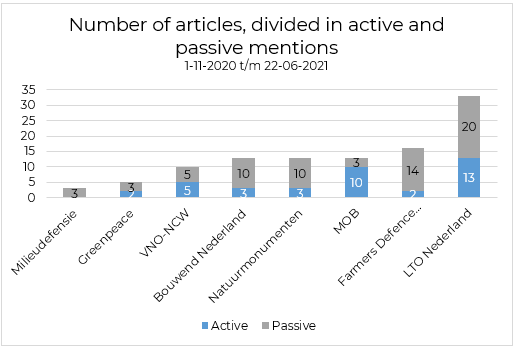This summer I will complete my internship and thesis research on how interest groups use the media in their lobby around the nitrogen debate.
As I wrote in my first blog, the nitrogen crisis received in the period around the elections relatively little attention. There were written 612 articles in almost 8 months (November 1, 2020 – June 23, 2021) in four daily Dutch newspapers. By way of comparison: in the same period 1,235 articles were written about the benefits affair (literal mentions) and almost 6,000 about the corona crisis (5,754 articles). The selected interest groups (Bouwend Nederland, Farmers Defense Force, Greenpeace, LTO Nederland, Milieudefensie, MOB, Natuurmonumenten and VNO-NCO) are listed in 86 articles (16%).
Nitrogen is seen as an important topic, Mark Rutte called it the ‘worst crisis in the nine years that I have been prime minister’ in November 2019. With such an important issue, my expectation was that stakeholders would be fully involved in the run-up to the elections. This expectation has not come true. De Telegraaf (March 5, 2021) writes about the nitrogen crisis: “It is hardly about it in the election battle, but it could well become one of the most difficult topics in the formation.”

Few active appointments, LTO clearly frontrunner
The graph below shows the number of articles per interest group. LTO Nederland is a clear outlier, with both active and passive listings. This can partly be explained by the arrival of Sjaak van der Taak as the new chairman in November 2020 and the media attention that came with it (9 articles).

In addition to the small number of articles, the interest groups are usually mentioned in a passive way. This means that they are rarely quoted or interviewed. In addition, many active appointments were not an active lobby for their nitrogen position but merely a comment about the existence or seriousness of the crisis.
The big question is why the interest groups are not actively visible. The interviews show that there is a difference between ‘newcomers’ and more institutionalized groups such as LTO and Bouwend Nederland. LTO has traditionally been a strong lobby organization with many policymakers and connections in political The Hague. This leads to good contact between the LTO and the ministry, according to LTO Nederland. The LTO says about lobbying through the media: “We don’t have to look it up ourselves, the media knows where to find us.”. It seems that LTO has direct access to the policymakers and therefore needs less media access to the system. Bouwend Nederland also indicates that the media finds them quickly when it comes to housing or infrastructure, for example. get redirected here đồng hồ rolex fake 1 tphcm handyhalterung auto review die perfekte kombination aus schoenheit und schutz die violette hibiskusblume auf der apple iphone x huelle purposes diamonds sauce 95 full spectrum cbd distillate 1 5g 001660 click this link where can i buy instalments
Other groups say they need the media agenda to influence the policy agenda, such as Farmers Defense Force and Greenpeace. FDF is mentioned in many articles in relation to their protests. I explain that FDF does not actively speak much because they use social media a lot. They can reach 60,000 people directly via Facebook. They themselves partly attribute it to the lack of application of the principle of hear-and-say by the mainstream media.
Here is a clear distinction between insiders and outsiders. The literature refers to an ‘iron triangle’ that describes the relationship between the ministry and political & interest groups. The term has the same meaning as ‘closed policy circuit’. The interest groups in the triangles, the insiders, have close contact with and easy access to the policymakers. This is more difficult for outsiders, such as nature and environmental organizations, and they are more likely to use outside lobbying tactics. However, given the limited number of mentions, these lobbying efforts seem ineffective.
Nitrogen plan
De Volkskrant writes that there is a tug-of-war between farmers and nature (Hofs, 2020). If I add the numbers of the business community/farmers on the one hand and the nature and environmental organizations (in 34 articles) on the other hand, the business community (72) wins the competition with ease. Bouwend Nederland itself explicitly states in the personal interviews I conducted that this contradiction no longer exists. This is reflected in the Nitrogen Plan, a coalition of LTO Nederland, Bouwend Nederland, Natuur&Milieu, MKB-Nederland, VNO-NCW and Natuurmonumenten. With this joint plan they want to pull the Netherlands out of the nitrogen impasse. According to Trouw, the organizations try to influence the formation in this way. Greenpeace is trying to do this in a completely different way, namely by threatening a lawsuit.
These results confirm the picture of a separation between the inside and outside groups. Smaller organizations, often with fewer resources and connections, try to influence the media agenda. The big old interest groups trust us more




